Related Research Articles

Bastille Day is the common name given in English-speaking countries to the national day of France, which is celebrated on 14 July each year. In French, it is formally called the Fête nationale française ; legally it is known as le 14 juillet.

Saint-Jean-Baptiste Day, also known in English as St John the Baptist Day, is a holiday celebrated on June 24 in the Canadian province of Quebec. It was brought to Canada by French settlers celebrating the traditional feast day of the Nativity of Saint John the Baptist. It was declared a public holiday in Quebec in 1925, with publicly financed events organized province-wide by a Comité organisateur de la fête nationale du Québec.
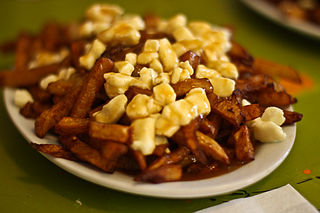
The cuisine of Québec is a national cuisine in the Canadian province of Québec. It is also cooked by Franco-Ontarians.

A king cake, also known as a three kings cake, is a cake associated in many countries with Epiphany. Its form and ingredients are variable, but in most cases a fève such as a figurine, often said to represent the Christ Child, is hidden inside. After the cake is cut, whoever gets the fève wins a prize. Modern fèves can be made of other materials, and can represent various objects and people.

A profiterole, cream puff (US), or chou à la crème is a filled French choux pastry ball with a typically sweet and moist filling of whipped cream, custard, pastry cream, or ice cream. The puffs may be decorated or left plain or garnished with chocolate sauce, caramel, or a dusting of powdered sugar. Savory profiterole are also made, filled with pureed meats, cheese, and so on. These were formerly common garnishes for soups.
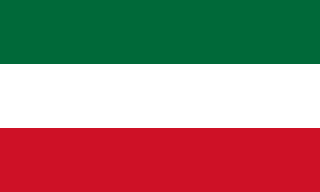
National Patriots' Day is a statutory holiday observed annually in the Canadian province of Quebec, on the Monday preceding 25 May. The holiday was established by the Lieutenant Governor of Quebec-in-Council in 2003, according to the Parti Quebecois premier Bernard Landry: "to underline the importance of the struggle of the patriots of 1837–1838 for the national recognition of our people, for its political liberty and to obtain a democratic system of government." Before 2003, the Monday preceding 25 May of each year was unofficially the Fête de Dollard, a commemoration initiated in the 1920s to coincide with Victoria Day, a federal holiday occurring annually on the same date.

There are eleven official public holidays in France. The Alsace region and the Moselle department observe two additional days. These holidays do not shift when they fall during a weekend, which means that the average number of observed public holidays falling on weekdays is 8.7 and ranges from seven to ten. Most Asian countries and all North American countries observe between two and ten more public holidays per year on weekdays.

The Fête de la Fédération was a massive holiday festival held throughout France in 1790 in honour of the French Revolution, celebrating the Revolution itself, as well as national unity.

The St. Honoré cake, usually known by its French name gâteau St-Honoré, and also sometimes called St. Honoratus cake, is a pastry dessert named for the French patron saint of bakers and pastry chefs, Saint Honoré or Honoratus, Bishop of Amiens. In 1847, it was invented by Auguste Julien, at the Chiboust bakery on Rue Saint-Honoré in Paris.
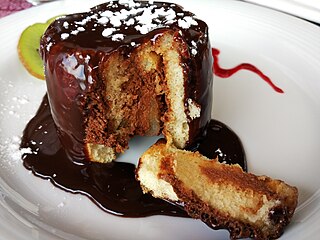
A charlotte is a type of bread pudding that can be served hot or cold. It is also referred to as an "icebox cake". Bread, sponge cake, crumbs or biscuits/cookies are used to line a mold, which is then filled with a fruit puree or custard. The baked pudding could then be sprinkled with powdered sugar and glazed with a salamander, a red-hot iron plate attached to a long handle, though modern recipes would likely use more practical tools to achieve a similar effect.
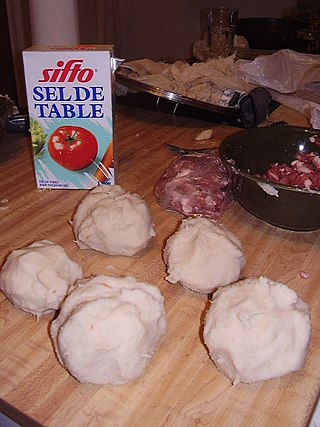
Acadian cuisine comprises the traditional dishes of the Acadian people. It is primarily seen in the present-day cultural region of Acadia. Acadian cuisine has been influenced by the Deportation of the Acadians, proximity to the ocean, the Canadian winter, bad soil fertility, the cuisine of Quebec, American cuisine, and English cuisine, among other factors.
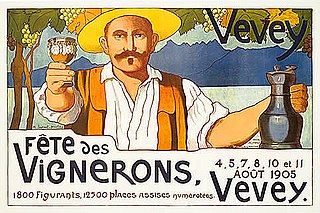
The Fête des Vignerons is a traditional festival which takes place in Vevey, in Switzerland.
Philippe Conticini is a French chef and pastry chef. Philippe Conticini has been described by the French press as "a pastry genius" and "one of the greatest pastry chefs of his time".

Hauts-de-France is the northernmost region of France, created by the territorial reform of French regions in 2014, from a merger of Nord-Pas-de-Calais and Picardy. Its prefecture is Lille. The new region came into existence on 1 January 2016, after regional elections in December 2015. The Conseil d'État approved Hauts-de-France as the name of the region on 28 September 2016, effective the following 30 September.

Maëva Coucke is a French model and beauty pageant titleholder who was crowned Miss France 2018. She represented France at Miss World 2018, where she placed in the top twelve, and also represented France at Miss Universe 2019, where she placed in the top ten. Coucke is the third Miss France winner from Nord-Pas-de-Calais within the span of four years, following Iris Mittenaere (2016) and Camille Cerf (2015).
Parc Bagatelle is a seasonal amusement park in Rang-du-Fliers, France. Founded in 1955, it is the oldest amusement park in France.
Jérôme Salomon is a French infectious diseases physician and high-ranking civil servant. He is the French Directeur général de la Santé since 8 January 2018. He became known in France since the COVID-19 pandemic.

Gil Jouanard was a French writer. His ability was discovered by René Char.

The Nord-Pas-de-Calais cuisine is a French regional cuisine, whose specialties are largely inherited from the county of Flanders. The region has always been at the intersection of Europe, and traces of its history can be found in its specialties, such as the English influence on the Côte d'Opale, or dishes of Polish origin in the mining basin.
References
- ↑ "Brève histoire du chausson aux pommes - Edélices". www.edelices.com. Retrieved 2023-03-14.
- ↑ editmairie (2021-08-12). "Fête du Chausson aux Pommes". Saint-Calais (in French). Retrieved 2023-03-15.
- ↑ chosesasavoir (2020-05-28). "Podcast Choses à Savoir D'où vient le chausson aux pommes ?". Choses à Savoir (in French). Retrieved 2023-03-15.
- ↑ "La Confrérie veille sur les chaussons aux pommes". France Ouest. Retrieved 14 March 2023.
- ↑ editmairie (2021-08-12). "Fête du Chausson aux Pommes". Saint-Calais (in French). Retrieved 2023-03-15.
- ↑ "Saint-Calais : La Fête du Chausson aux Pommes dans sa 392e édition". actu.fr (in French). Retrieved 2023-03-15.